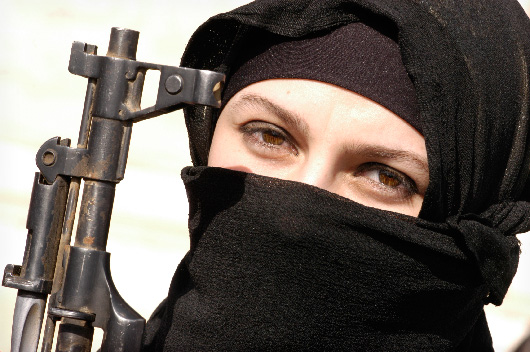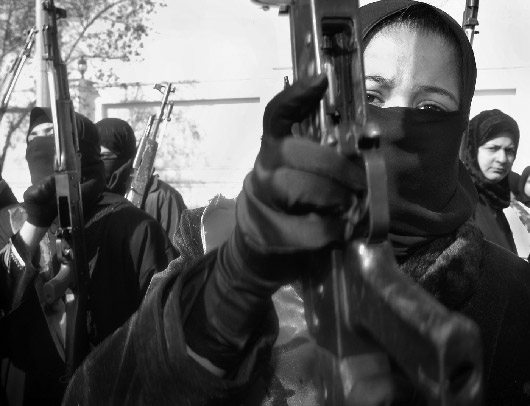Sura

From Night of a Thousand Stars and Other Portraits of Iraq (Nazraeli Press: 2006)
She is one of a group of about 150 armed militiawomen who’ve surrounded me on a parade ground in Tikrit, Iraq⎯circling, jabbing the air with their Kalishnikov’s, chanting, “Down with Bush! Down with U.S.A.!”
We’re all enduring the annual Al Quds Militia parade, held here every February 8 to celebrate the birthday of Sadaam Hussein, whose rags-to-rags story began in a hamlet on the outskirts of this desolate desert town.
I doubt that many of the women understand the script that’s been handed to them. It’s a drama that’s obviously been choreographed by some Ba’ath Party propagandist in an effort to teach recruits how to appear menacing for three seconds on CNN and the BBC.
I’m one of 20 western journalists present to witness this spectacle⎯45,000 civilians marching to prove, as Hussein has promised, that the Iraqis will greet American invaders with “bullets, not flowers.”
I don’t know what else to do⎯I shouldn’t, can’t, force my way out⎯so I begin photographing. A woman with caramel eyes circles at the rear, and stops to watch me. I take two shots before she can move, then check the image on the digital monitor. When I look up, she’s still facing me, curious. I spin the camera around and, holding it by the lens, push it towards her with the monitor lit.
The woman standing beside her sees it first. “Jamila!” she gasps—beautiful—and leans forward to better see. Women, circling, knock up against her, follow her eyes to the camera. The woman in the photo takes a step forward. Her eyes widen.
“Jamila!” another woman, leaning down, cries out, and looks from the camera to my face, startled. I turn in a slow circle, holding my hand over the monitor as an umbrella so the sun won’t wash out the image. Rifles fall from the sky as women stop chanting and crowd toward me, stooping down, squinting against the light. Someone is speaking rapidly in Arabic, telling women to look at the photo.
No one wants to be left out. Throughout the circle, women are calling, “Ta ah shoof? Ta ah shoof?”
Can I see? Can I see?
Then, rising, they beg, “Sura, sura!” Take my picture! Take my picture!
Women pose now, giggling, holding hands, flirting wordlessly, pleading for more photos, begging to see themselves in the monitor, un-slinging their rifles, standing straight-backed and regal, tucking in their abayas, vogueing for the camera. It’s chaos. In the space of two minutes, it’s gone from imminent war to militant fashion shoot.
There’s one holdout. A woman says, forcefully, “Sadaam Hussein … good!”
I can’t resist. I say, quietly, “You really think so? I don’t think so.”
A woman standing near the front translates this into Arabic, loudly enough to be heard by the women in the circle, but not by a group of Iraqi Army officers, all men, loitering by a parked jeep 20 yards to the west. Across the field, ranks of weary conscripts are disbanding. A one-armed soldier walks by, empty-handed. A column of shabbily dressed, haggard old men, some limping, some easily in their late 60s, straggles over the pavement toward the parking lot, anxious to be bused back to their hometowns: Baghdad, Samarra, Falluja.

None of the women argues.
I say, “Your president and my president are going to get us killed. I don’t think Sadaam Hussein is good and I don’t think George Bush is good. I think people are good.”
The woman who has been translating now stares at me for what seems like an eternity. Then she nods her head yes and, looking around the circle, tells the militiawomen what I’ve said.
Around the circle, they stand with the butts of their rifles resting against the ground, glancing at one another and then back at me. Some nod in agreement, almost imperceptibly. Most are veiled. I see only their eyes, and the sadness there, how afraid they are, how they plead in silence, saying,
I was beautiful, this was my body, sura, these were my hours, take my picture, sura, show them I was beautiful, sura, take my picture, don’t let them forget … I want to be remembered.
I search their faces, trying to not forget, because I know it will be difficult to see through the days ahead.
I want to remember them not as images on film, but how they are here, now—beautiful in my eyes.
The translator says, in perfect English, “People are good.”
“People are good,” I say again.
Even with her face masked⎯save for her eyes⎯I can see she is smiling. She cocks her head to the side and says, “What’s your name?”
“Joel,” I say. “What’s yours?” The End
Notes on Al Quds Militiawoman
The photograph is deeply personal to me; the experience of taking the photo, and seeing how it changed the behavior of ‘the enemy,’ reminds me daily of the power documentary photography has in (and over) people’s lives. I wish that beauty (by which I don’t just mean corporeal or temporal beauty) alone could save us. Could have saved them. And others. I wish we (we journalists, and we meaning humanity) could have found enough beauty in our own citizens, our troops, to not sacrifice them in Iraq.
I think that any image that humanizes a person makes that person harder to see as an enemy, and therefore more difficult to harm. Or so I believe. So I feel. So I’ve seen.
Two years ago the militiawoman photo was exhibited in a Portland, Ore. gallery, and I overheard a woman, who was inspecting the image closely, say, “I don’t see anything that proves it’s from Iraq. It looks like it could have been taken anywhere.”
I introduced myself as the photographer, and asked her what was missing that would have proved the woman was Iraqi. She considered the photo for a few moments, then shrugged.
I asked, “Do you mean you’re wondering whether she’s Iraqi … because there’s no mosque? No sand dunes? No camel?”
She blushed. She looked embarrassed. “Yeah,” she admitted, “I guess that’s it.”
I told her I thought it was interesting, and kind of sad, that we’d reached the point at which portraits of Iraqis had to include an AK-47 and/or a camel/sand dune/mosque before we could accept that there were Iraqi. In other words, who were people, and could be coincidentally Iraqi. Sad that we cannot accept them as such without having to prop them up on a camel, or “document” them in front of a minaret, before we could believe they were Iraqi.
When the question (of authenticity—is this is a real photograph, is this a human being) comes up, I sometimes ask the viewer, “What do you think would have to be present in an image before an Iraqi would believe that the person being pictured is American?”
Is it a pair of hip-hugger Levi’s and a pierced belly-button? A crew-cut and a Humvee? Are there assemblages of cosmetics, clothing and possessions that—in the presence of a human being—prove a person is a United States citizen?
It’s a troubling exercise, an existential dilemma. It makes some people uncomfortable. I see it in their faces. The frowning. The contortions as their faces and bodies and minds wrestle with it. Some people touch their faces, unconsciously, as they search for an answer; I’ve never seen anyone jingle a set of car keys, or point to a Gucci purse, crying Eureka! I’ve got it!
It’s clear the answer isn’t something that can be seen.
The question leads to the suspicion that our very existence, in the eyes of others, might be contingent on the same dehumanizing stereotypes we apply to them. It leads to guilt, to sadness. That anyone could be so foolish. That we sometimes see only in categories, seeing labels, not the “content” of the person. (This is a good place for me to say, “Thank you, Dr. King, for reminding us that if we’re to judge at all, let’s judge by the content of one’s character.”)
I’m sure it leads to other things as well; for some, it leads nowhere. Blankness. Self-imposed blindness. A kind of desolation of the soul. I know that some people simply cannot accept that human beings are not, fundamentally, merely assemblages of race, religion and a few “ethnic” accessories. These people as lumped together under one label. Enemy. Or the less committal, but equally distant other.
The image, the experience of taking it, and the comments I’ve heard from viewers help me think about how photographs can efface, as well as humanize. I suspect that it’s an exposure problem; we’ve been inundated with images that provide ‘context’ about Iraqis, but seemingly few that ask us to consider the life itself being depicted.
Few images that compel us to see an Iraqi as a life—one that’s simply being lived. Being lived in Iraq. The End
04/30/11 | 0 Comments | Sura